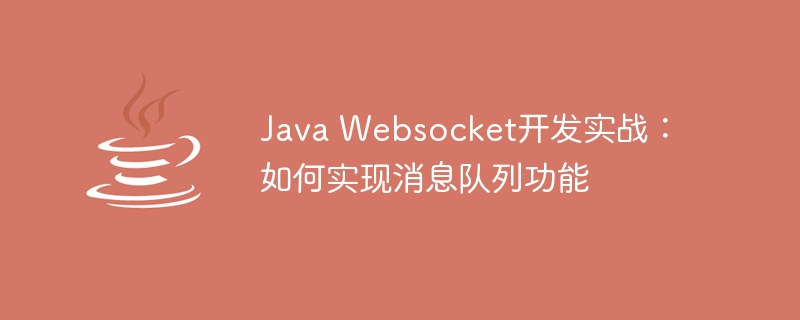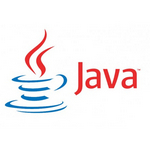
Java Websocket开发实战:如何实现消息队列功能
引言:
随着互联网的迅速发展,实时通信变得越来越重要。在许多Web应用程序中,需要通过实时消息传递来实现实时更新和通知功能。Java Websocket是一种在Web应用程序中实现实时通信的技术。本文将介绍如何利用Java Websocket来实现消息队列功能,并提供具体的代码示例。
1.1 消息生产者(Producer):负责产生并发送消息到队列中。
1.2 消息队列(Queue):用来存储消息的数据结构,按照一定的规则保存和管理消息。
立即学习“Java免费学习笔记(深入)”;
1.3 消息消费者(Consumer):从队列中获取消息,并进行处理或发送给相应的接收者。
若要使用Java Websocket实现消息队列功能,我们需要做如下几个步骤:
2.1 建立WebSocket连接
Java Websocket提供了WebSocket类来建立WebSocket连接。我们可以通过继承javax.websocket.Endpoint类,并重写其onOpen方法来处理连接的建立。下面是一个简单的示例:
import javax.websocket.Endpoint;
import javax.websocket.EndpointConfig;
import javax.websocket.Session;
import javax.websocket.CloseReason;
import javax.websocket.OnClose;
import javax.websocket.OnError;
import javax.websocket.OnMessage;
import javax.websocket.OnOpen;
import javax.websocket.server.ServerEndpoint;
@ServerEndpoint("/websocket")
public class WebSocketServer extends Endpoint {
@OnOpen
public void onOpen(Session session, EndpointConfig config) {
// 连接建立时的逻辑处理
}
@OnMessage
public void onMessage(String message, Session session) {
// 收到消息时的逻辑处理
}
@OnClose
public void onClose(Session session, CloseReason closeReason) {
// 连接关闭时的逻辑处理
}
@OnError
public void onError(Session session, Throwable throwable) {
// 发生错误时的逻辑处理
}
}2.2 实现消息生产者
在onMessage方法中,我们可以根据接收到的消息内容进行相应的处理。对于一个消息队列而言,我们需要将接收到的消息存储起来,并在需要的时候发送给相应的消费者。下面是一个简单的示例代码:
import javax.websocket.Session;
import java.util.Queue;
import java.util.concurrent.ConcurrentLinkedQueue;
public class MessageProducer {
private static final Queue<String> messageQueue = new ConcurrentLinkedQueue<>();
public static void addMessage(String message) {
messageQueue.add(message);
}
public static void sendMessage(Session session) {
while (!messageQueue.isEmpty()) {
String message = messageQueue.poll();
session.getBasicRemote().sendText(message);
}
}
}2.3 实现消息消费者
消息消费者负责从消息队列中获取消息,并进行相应的处理。在WebSocket连接建立后,可以调用MessageProducer.sendMessage(session)方法来将消息发送给消息消费者。下面是一个简单的示例代码:
import javax.websocket.OnOpen;
import javax.websocket.Session;
import javax.websocket.server.ServerEndpoint;
@ServerEndpoint("/websocket")
public class WebSocketServer {
@OnOpen
public void onOpen(Session session) {
MessageProducer.sendMessage(session);
}
}3.1 创建WebSocket服务端
创建一个WebSocket服务端,用于接收客户端发送的消息,并将消息存储到消息队列中。下面是一个简单的示例代码:
import javax.websocket.Session;
import java.util.Queue;
import java.util.concurrent.ConcurrentLinkedQueue;
@ServerEndpoint("/websocket")
public class WebSocketServer {
private static final Queue<String> messageQueue = new ConcurrentLinkedQueue<>();
@OnMessage
public void onMessage(String message, Session session) {
messageQueue.add(message);
}
@OnOpen
public void onOpen(Session session, EndpointConfig config) {
while (!messageQueue.isEmpty()) {
String message = messageQueue.poll();
session.getBasicRemote().sendText(message);
}
}
}3.2 创建WebSocket客户端
创建一个WebSocket客户端,用于发送消息给WebSocket服务端。下面是一个简单的示例代码:
import javax.websocket.ClientEndpoint;
import javax.websocket.OnMessage;
import javax.websocket.Session;
@ClientEndpoint
public class WebSocketClient {
private static Session session;
public static void main(String[] args) {
WebSocketContainer container = ContainerProvider.getWebSocketContainer();
session = container.connectToServer(WebSocketClient.class, URI.create("ws://localhost:8080/websocket"));
session.getBasicRemote().sendText("Hello, WebSocket!");
}
@OnMessage
public void onMessage(String message, Session session) {
System.out.println("Received message: " + message);
}
}参考文献:
以上就是Java Websocket开发实战:如何实现消息队列功能的详细内容,更多请关注php中文网其它相关文章!

java怎么学习?java怎么入门?java在哪学?java怎么学才快?不用担心,这里为大家提供了java速学教程(入门到精通),有需要的小伙伴保存下载就能学习啦!

Copyright 2014-2025 https://www.php.cn/ All Rights Reserved | php.cn | 湘ICP备2023035733号